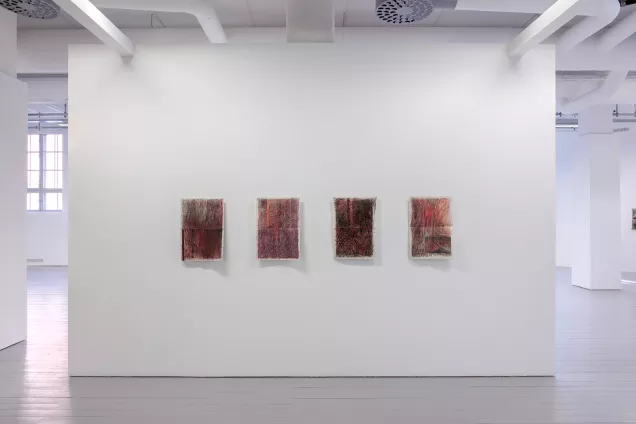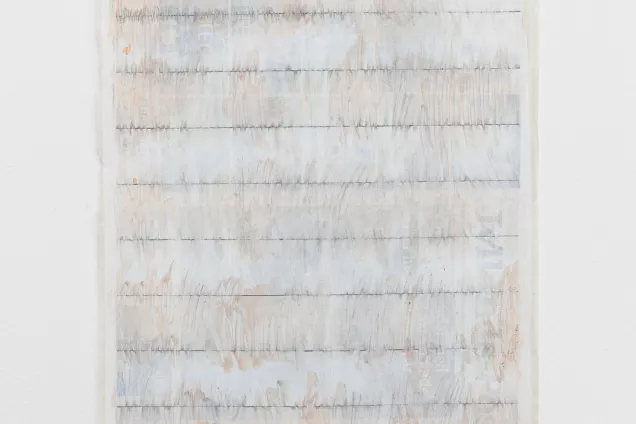Anne Sofie Djernis
Anne Sofie Djernis´ MFA exhibition entitled “There is no emotional connection to numbers on a gravestone without a story being told” consisted of paintings, either on canvas or on newspaper. The paintings had an expanded colorscape and suggested different meditative states.
In the hand-out text Djernis mentioned how “In a meditative state, you observe” as a way she understood her own contemplation of becoming aware of the gravestones in a cemetery she used for a leisurely walk.
How has the process been of creating this exhibition?
It felt very much like an unfolding, where I didn't know the beginning or the destination. But rather trying to find out something about both painting and the content within it.
If I have to locate a beginning, I think it started with the cemetery - or maybe it was the newspapers. Or, more precisely, it was two different paths that eventually met. In both cases it was a reflection on a way of seeing and relating to the world.
How it started with the newspapers was that for several years I had kind of avoided the news, often being oblivion about what was going on in the world and only being informed by the people around me. My mom would sometimes call me to tell me if something really important or terrible had happened that she thought I should know about - she wanted me to be informed. Then I decided to do a project about reading newspapers and being more informed. But because I didn't want to be exposed to just one newspaper bias, I wanted to read the 7 biggest newspapers in Denmark. The plan was to do it for 4 hours a day for 30 days, but I could only do it for 12 days. Then I started to paint again and stopped reading newspapers. It was a great relief to stop. At the beginning of the project I felt very stimulated by all the information. It made me think and reflect, but as the days went by I felt more and more numb by it. And I found that my own judgment of the things I was reading about was decreasing. As if I didn't have the time or energy to process it.
After that, I started going for walks at the cemetery. Here I felt a relief. I felt that here I could breath and that time and space was going in a different pace. I enjoyed the surroundings, the silence, the smells of the flowers and the visuality of the trees up against the sky. It was a place where I could let go into the senses and kind of enter a meditative state. And in that state I also became aware of how my attention was mainly on the sensations of pleasurable things and that the gravestones, and the information on them, which can also be understood as representations of death, was being ignored. And I wanted to deal with that in my paintings.
I tried to do that in different ways, by painting images from the cemetery, but also by using notes that I had taken from the cemetery of the information on the gravestones and then using that as a basis for the paintings. But then in the painting process it becomes about something else - it becomes more about the bodily experience of sensations. I also started thinking about this way of looking and this relationship to information through other existing paintings and painting practices.
But I began to feel that something was missing in the paintings, as if the information in them would always disappear. And I found that the newspaper drawing was kind of my solution, because here the information was always part of the foundation. The information was the canvas and they made it clear that by looking at the painting, you were also ignoring something.
The exhibitions were not well thought out, based on a concept or something, and then executed. It was more a process of listening to my curiosity and then discovering where it would take me. This was also very frustrating, because I was very concerned that the paintings I was making were disconnected from each other, because they also had very different expressions. But at the same time, I felt that I needed to explore these different expressions, and that it would be restrictive and uninteresting for me to work with just one kind of painterly language. As if I needed the different expressions to understand something.
What has your inspiration been?
For a long time I was mainly looking for images from the digital sphere, but when my process for this exhibition started, without knowing it, I was looking for images from a different place. I also had a strong desire to do a different kind of painting; a more bodily kind of painting. I used to work much more graphically, but now I started to feel that I understood painting in a different way; that I should give myself more into the body and listen to the body rather than to rational thoughts. It made the paintings looser and also more abstract. Because the body does not care about figuration - I experience that it is more a mental thing.
Anne Sofie Djernis's exhibition was displayed at Malmö Art Gallery (KHM1) March 22nd - April 6th 2024.
Interview by Karin Hald.
Cornelia Hermansson
In the upper gallery (KHM2) at Malmo Art Academy, I entered the MFA exhibition “Pendang” by Cornelia Hermansson. The exhibition consisted of paintings, ranging in size and which all was floating in between a state of imagery, which shapes I recognized and yet was abstract. It was almost the sensation of an image which was both in and out of focus.
How has the process been of creating this exhibition?
It actually resembles many other processes of mine, because the exhibition is based on my ongoing work in the studio. I don't work project-based or with a wide variety of working methods. I work best in the morning and can't paint for too many hours straight. During the autumn I found it difficult to paint in larger formats, perhaps the tension before the exhibition had something to do with that. Instead, I painted several smaller paintings that helped me go further. Yet the weeks right before the exhibition were the best, strangely. In those weeks I painted several of the paintings that ended up on the walls in the exhibition.
Everything around an exhibition, such as text material, is almost a necessary evil for me. Even titles can sometimes feel difficult. I am focused on, and occupied with, the image itself. A visitor can maybe sense this in the exhibition, I have not made any interventions in the room but instead wanted to work solely with the paintings' own potential.
What has your inspiration been?
One answer to that question is probably that intuition has been more important in my work than inspiration. But I could also say that I am inspired by how an image can precede words. I am inspired by how something urgent, often unexpected, can be shown through pictures. I am also inspired by shapes, by not being able to fully map them.
Another answer would be that I feel inspired when I read the poet Ann Jäderlund.
How have you worked on selecting what you wanted to paint especially in relation to the level of abstraction which is present in each painting?
My paintings come about through the process of painting, there is rarely a predetermined motif. I have felt for quite a long time, maybe even since I started painting, that abstraction helps me shape even what the eye reads as figuration, or something that is recognisable. I hesitate to make a division. Rather, the meeting between the figurative and the abstract is interesting. The image that has the ability to be drifting, the one that eludes me, is the image I long to see.
The material you use to paint with, oil, seems to be of great importance to you, as also emphasized in the introduction text by Olle Helin, where he writes of your paintings: “synthetic pigments and modern symbols bring them forward to the presents”.
How does oil as a material shape the paintings?
Oil paint has the capacity to be both light, glassy and heavy, oily. In this way, the characteristics of paint can approach and shape sensory experiences. I return to certain colours again and again, purple, yellow, brown and red. A single colour is practically inexhaustible. I appreciate when a colour can be experienced both as beautiful and a little prickly. This is often somewhat subjective.
Cornelia Hermansson's exhibition was displayed at Malmö Art Gallery (KHM2) March 22nd - April 6th 2024.
Interview by Karin Hald.
Exhibition photos
There is no emotional connection to numbers on a gravestone without a story being told, by Anne Sofie Djernis
Pendang, by Cornelia Hermansson

There is no emotional connection to numbers on a gravestone without a story being told by Anne Sofie Djernis. Photo: Youngjae Lih.

Pendang, by Cornelia Hermansson. Photo: Youngjae Lih.

There is no emotional connection to numbers on a gravestone without a story being told by Anne Sofie Djernis. Photo: Youngjae Lih.

Pendang, by Cornelia Hermansson. Photo: Youngjae Lih.

There is no emotional connection to numbers on a gravestone without a story being told by Anne Sofie Djernis. Photo: Youngjae Lih.

Pendang, by Cornelia Hermansson. Photo: Youngjae Lih.

There is no emotional connection to numbers on a gravestone without a story being told by Anne Sofie Djernis. Photo: Youngjae Lih.

Pendang, by Cornelia Hermansson. Photo: Youngjae Lih.

There is no emotional connection to numbers on a gravestone without a story being told by Anne Sofie Djernis. Photo: Youngjae Lih.

Pendang, by Cornelia Hermansson. Photo: Youngjae Lih.

There is no emotional connection to numbers on a gravestone without a story being told by Anne Sofie Djernis. Photo: Youngjae Lih.

Pendang, by Cornelia Hermansson. Photo: Youngjae Lih.

There is no emotional connection to numbers on a gravestone without a story being told by Anne Sofie Djernis. Photo: Youngjae Lih.

Pendang, by Cornelia Hermansson. Photo: Youngjae Lih.
